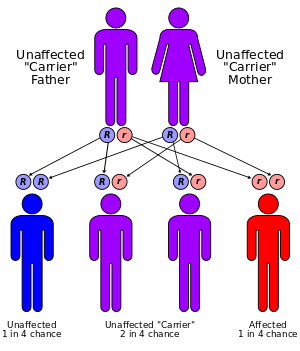Renal-hepatic-pancreatic dysplasia
| Renal-hepatic-pancreatic dysplasia | |
|---|---|
 | |
| Gross photo of liver and pancreas showing multiple cysts in the latter in a patient with renal-hepatic-pancreatic dysplasia. | |
| Classification and external resources | |
| OMIM | 208540 |
Renal-hepatic-pancreatic dysplasia is an autosomal recessive congenital disorder characterized by pancreatic fibrosis, renal dysplasia and hepatic dysgenesis. It is usually fatal soon after birth.
An association with NPHP3 as been described.[1]
It was characterized in 1959.[2][3]

Renal-hepatic-pancreatic dysplasia has an autosomal recessive pattern of inheritance.
References
- ↑ Bergmann C, Fliegauf M, Brüchle NO, et al. (April 2008). "Loss of nephrocystin-3 function can cause embryonic lethality, Meckel-Gruber-like syndrome, situs inversus, and renal-hepatic-pancreatic dysplasia". Am. J. Hum. Genet. 82 (4): 959–970. doi:10.1016/j.ajhg.2008.02.017. PMC 2427297
 . PMID 18371931.
. PMID 18371931. - ↑ Vankalakunti M, Gupta K, Kakkar N, Das A (2007). "Renal-hepatic-pancreatic dysplasia syndrome (Ivemark's syndrome)". Diagn Pathol. 2: 24. doi:10.1186/1746-1596-2-24. PMC 1919354
 . PMID 17605805.
. PMID 17605805. - ↑ IVEMARK BI, OLDFELT V, ZETTERSTROM R (January 1959). "Familial dysplasia of kidneys, liver and pancreas: a probably genetically determined syndrome". Acta Paediatr. 48 (1): 1–11. doi:10.1111/j.1651-2227.1959.tb16011.x. PMID 13626573.
This article is issued from Wikipedia - version of the 5/27/2016. The text is available under the Creative Commons Attribution/Share Alike but additional terms may apply for the media files.